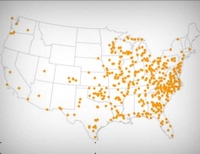Fixing prison-based gerrymandering after the 2010 Census: Vermont
50 State Guide, March 2010
- Sections
- Impact at the state level
- Vermont law says a prison cell is not a residence
- Solutions
- Additional resources
Prison-based gerrymandering violates the constitutional principle of "One Person, One Vote." The Supreme Court requires districts to be based on equal population in order to give each resident the same access to government. But a longstanding flaw in the Census counts incarcerated people as residents of the prison location, even though they can’t vote and aren’t a part of the surrounding community.
When legislators claim people incarcerated in their districts are legitimate constituents, they award people who live close to the prison more of a say in government than everybody else.
Impact at the state level:
- The state’s prison population comes disproportionately from some cites:
- Burlington is home for 6.1% of the state, but 8.5% of its incarcerated people.
- Rutland is home for 2.8% of the state, but 4.8% of its incarcerated people.
- Bennington is home for 2.6% of the state, but 4.5% of its incarcerated people.
- Crediting the state’s incarcerated population to the census blocks that contain the state’s 8 correctional facilities serves to enhance the weight of a vote cast in those 8 districts while diluting those cast in every other district. The most significantly enhanced districts drawn after the 2000 Census are:
- State House District Chittenden-3-10 is 3.8% incarcerated
- State House District Orleans-2 is 3.3% incarcerated.
- State House District Caledonia-3 is 3.1% incarcerated.
- State House District Franklin-1 is 2.9% incarcerated.
Vermont law says a prison cell is not a residence:
- “A person shall not gain or lose a residence solely by reason of presence or absence… while confined in a prison or correctional institution.” (Vermont Annotated Statutes, Title 17, §2122(a).)
- In Vermont prisoners do not lose the right to vote while they are incarcerated. When they vote, they vote absentee at their home address.
Solutions:
- Ideally, the U.S. Census Bureau would change where it counts incarcerated people. They should be counted as residents of their home — not prison — addresses. There is no time for that in 2010, but Vermont should ask the Census Bureau for this change for 2020.
Additional resources:
- If prisoners could vote, they would vote at home, not in the prison town, by Peter Wagner, December 15, 2003
Events
- April 30, 2025:
On Wednesday, April 30th, at noon Eastern, Communications Strategist Wanda Bertram will take part in a panel discussion with The Center for Just Journalism on the 100th day of the second Trump administration. They’ll discuss the impacts the administration has had on criminal legal policy and issues that have flown under the radar. Register here.
Not near you?
Invite us to your city, college or organization.



